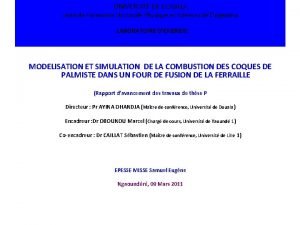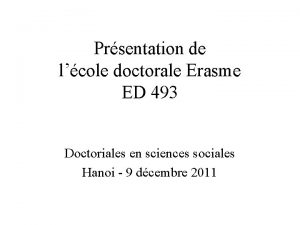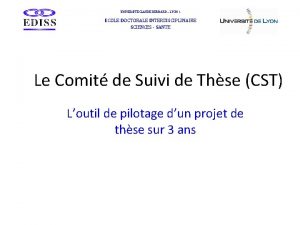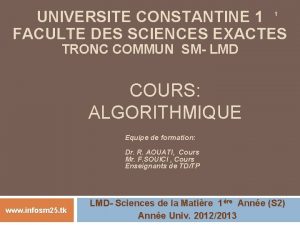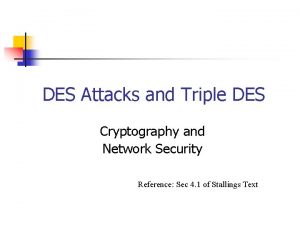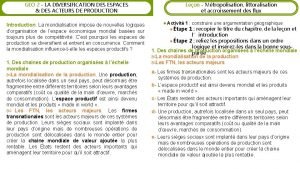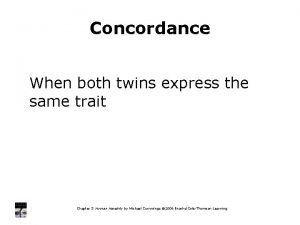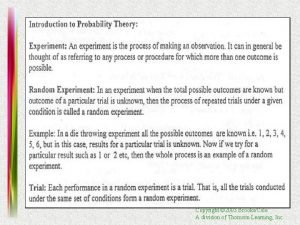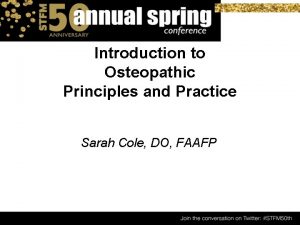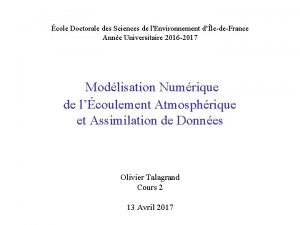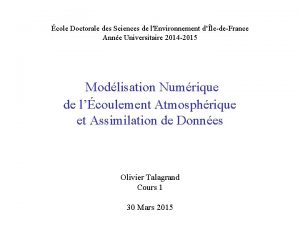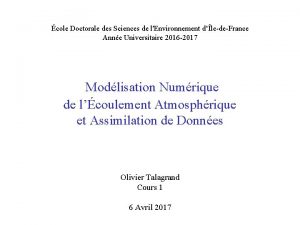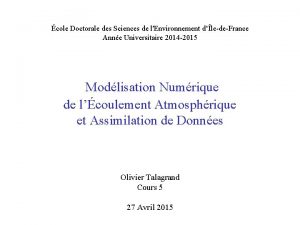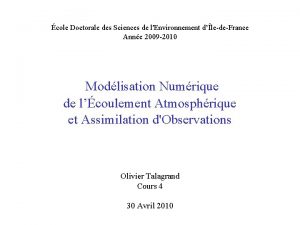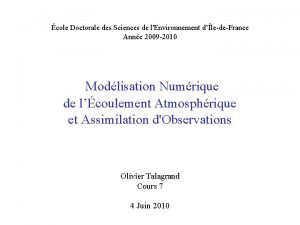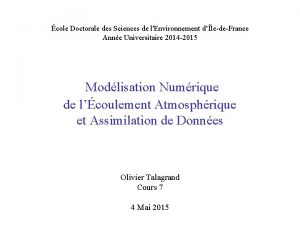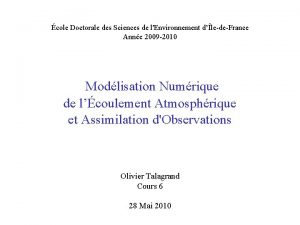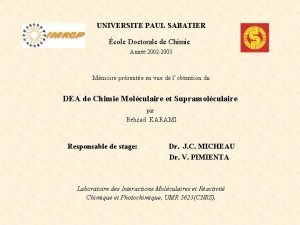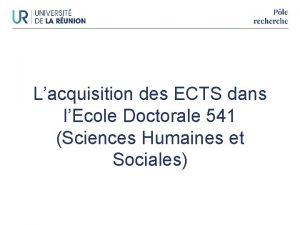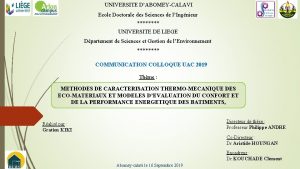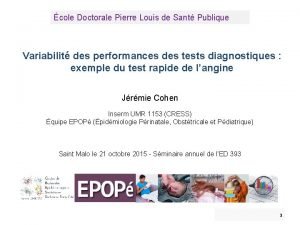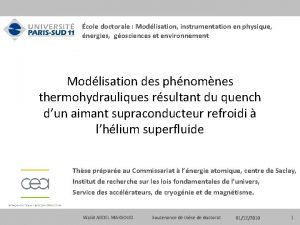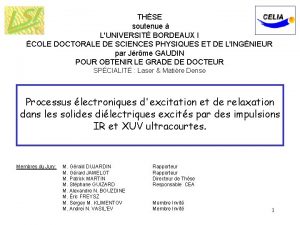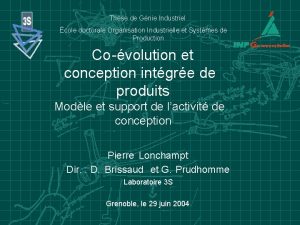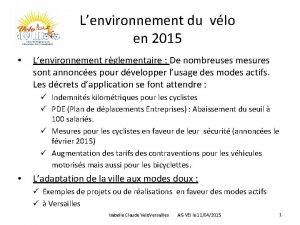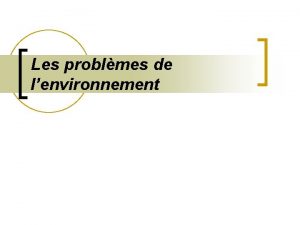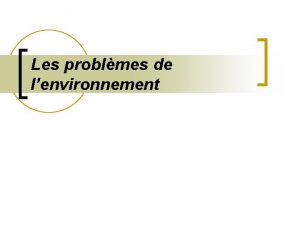cole Doctorale des Sciences de lEnvironnement dledeFrance Anne







































![Data of the form z = x + N [ , S] Known data Data of the form z = x + N [ , S] Known data](https://slidetodoc.com/presentation_image_h/fc33cda68706a23b8489171b5fc68a79/image-40.jpg)

![Conditional probability distribution P(x z) = N [xa, Pa] with xa = ( T Conditional probability distribution P(x z) = N [xa, Pa] with xa = ( T](https://slidetodoc.com/presentation_image_h/fc33cda68706a23b8489171b5fc68a79/image-42.jpg)




































- Slides: 78

École Doctorale des Sciences de l'Environnement d’Île-de-France Année Universitaire 2014 -2015 Modélisation Numérique de l’Écoulement Atmosphérique et Assimilation de Données Olivier Talagrand Cours 8 7 Mai 2015

Exact bayesian estimation ? Particle filters Predicted ensemble at time t : {xbn, n = 1, …, N }, each element with its own weight (probability) P(xbn) Observation vector at same time : y = Hx + Bayes’ formula P(xbn y) P(y xbn) P(xbn) Defines updating of weights

Bayes’ formula P(xbn y) P(y xbn) P(xbn) Defines updating of weights; particles are not modified. Asymptotically converges to bayesian pdf. Very easy to implement. Observed fact. For large state dimension, ensemble tends to collapse.

C. Snyder, http: //www. cawcr. gov. au/staff/pxs/wmoda 5/Oral/Snyder. pdf

Problem originates in the ‘curse of dimensionality’. Large dimension pdf’s are very diffuse, so that very few particles (if any) are present in areas where conditional probability (‘likelihood’) P(y x) is large. Bengtsson et al. (2008) and Snyder et al. (2008) evaluate that stability of filter requires the size of ensembles to increase exponentially with space dimension.

Alternative possibilities (review in van Leeuwen, 2009, Mon. Wea. Rev. , 4089 -4114) Resampling. Define new ensemble. Simplest way. Draw new ensemble according to probability distribution defined by the updated weights. Give same weight to all particles. Particles are not modified, but particles with low weights are likely to be eliminated, while particles with large weights are likely to be drawn repeatedly. For multiple particles, add noise, either from the start, or in the form of ‘model noise’ in ensuing temporal integration. Random character of the sampling introduces noise. Alternatives exist, such as residual sampling (Lui and Chen, 1998, van Leeuwen, 2003). Updated weights wn are multiplied by ensemble dimension N. Then p copies of each particle n are taken, where p is the integer part of Nwn. Remaining particles, if needed, are taken randomly from the resulting distribution.

Importance Sampling. Use a proposal density that is closer to the new observations than the density defined by the predicted particles (for instance the density defined by En. KF, after the latter has used the new observations). Independence between observations is then lost in the computation of likelihood P(y x) (or is it not ? ) In particular, Guided Sequential Importance Sampling (van Leeuwen, 2002). Idea : use observations performed at time k to resample ensemble at some timestep anterior to k, or ‘nudge’ integration between times k-1 and k towards observation at time k.

van Leeuwen, 2003, Mon. Wea. Rev. , 131, 2071 -2084

Particle filters are actively studied (van Leeuwen, Morzfeld, …)

If there is uncertainty on the state of the system, and dynamics of the system is perfectly known, uncertainty on the state along stable modes decreases over time, while uncertainty along unstable modes increases. Stable (unstable) modes : perturbations to the basic state that decrease (increase) over time.


Consequence : Consider 4 D-Var assimilation, which carries information both forward and backward in time, performed over time interval [t 0, t 1] over uniformly distributed noisy data. If assimilating model is perfect, estimation error is concentrated in stable modes at time t 0, and in unstable modes at time t 1. Error is smallest somewhere within interval [t 0, t 1]. Similar result holds true for Kalman filter (or more generally any form of sequential asimilation), in which estimation error is concentrated in unstable modes at any time.

Trevisan et al. , 2010, Q. J. R. Meteorol. Soc.


Lorenz (1963) dx/dt = (y-x) dy/dt = x - y - xz dz/dt = - z + xy with parameter values = 10, = 28, = 8/3 chaos



Pires et al. , Tellus, 1996 ; Lorenz system (1963)

Minima in the variations of objective function correspond to solutions that have bifurcated from the observed solution, and to different folds in state space.

Quasi-Static Variational Assimilation (QSVA). Increase progressively length of the assimilation window, starting each new assimilation from the result of the previous one. This should ensure, at least if observations are in a sense sufficiently dense in time, that current estimation of the system always lies in the attractive basin of the absolute minimum of objective function (Pires et al. , Swanson et al. , Luong, Järvinen et al. ).

Pires et al. , Tellus, 1996 ; Lorenz system (1963)


Swanson, Vautard and Pires, 1998, Tellus, 50 A, 369 -390

Since, after an assimilation has been performed over a period of time, uncertainty is likely to be concentrated in modes that have been unstable, it might be useful for the next assimilation, and at least in terms of cost efficiency, to concentrate corrections on the background in those modes. Actually, presence of residual noise in stable modes can be damageable for analysis and subsequent forecast. Assimilation in the Unstable Subspace (AUS) (Carrassi et al. , 2007, 2008, for the case of 3 D-Var)

Four-dimensional variational assimilation in the unstable subspace (4 DVar-AUS) Trevisan et al. , 2010, Four-dimensional variational assimilation in the unstable subspace and the optimal subspace dimension, Q. J. R. Meteorol. Soc. , 136, 487 -496.

4 D-Var-AUS Algorithmic implementation Define N perturbations to the current state, and evolve them according to the tangent linear model, with periodic reorthonormalization in order to avoid collapse onto the dominant Lyapunov vector (same algorithm as for computation of Lyapunov exponents). Cycle successive 4 D-Var‘s, restricting at each cycle the modification to be made on the current state to the space spanned by the N perturbations emanating from the previous cycle (if N is the dimension of state space, that is identical with standard 4 D-Var).

Experiments performed on the Lorenz (1996) model with value F = 8, which gives rise to chaos. Three values of I have been used, namely I = 40, 60, 80, which correspond to respectively N+ = 13, 19 and 26 positive Lyapunov exponents. In all three cases, the largest Lyapunov exponent corresponds to a doubling time of about 2 days (with 1 ‘day’ = 1/5 model time unit). Identical twin experiments (perfect model)

Lorenz’ 96 model (M. Jardak)

‘Observing system’ defined as in Fertig et al. (Tellus, 2007): At each observation time, one observation every four grid points (observation points shifted by one grid point at each observation time). Observation frequency : 1. 5 hour Random gaussian observation errors with expectation 0 and standard deviation 0 = 0. 2 (‘climatological’ standard deviation 5. 1). Sequences of variational assimilations have been cycled over windows with length = 1, … , 5 days. Results are averaged over 5000 successive windows.

No explicit background term (i. e. , with error covariance matrix) in objective function : information from past lies in the background to be updated, and in the N perturbations which define the subspace in which updating is to be made. Best performance for N slightly above number N+ of positive Lyapunov exponents.

Different curves are almost identical on all three panels. Relative improvement obtained by decreasing subspace dimension N to its optimal value is largest for smaller window length .


Experiments have been performed in which an explicit background term was present, the associated error covariance matrix having been obtained as the average of a sequence of full 4 D-Var’s. The estimates are systematically improved, and more for full 4 D-Var than for 4 D-Var-AUS. But they remain qualitatively similar, with best performance for 4 D-Var-AUS with N slightly above N+.

Minimum of objective function cannot be made smaller by reducing control space. Numerical tests show that minimum of objective function is smaller (by a few percent) for full 4 D-Var than for 4 D-Var-AUS. Full 4 D-Var is closer to the noisy observations, but farther away from the truth. And tests also show that full 4 D-Var performs best when observations are perfect (no noise). Results show that, if all degrees of freedom that are available to the model are used, the minimization process introduces components along the stable modes of the system, in which no error is present, in order to ensure a closer fit to the observations. This degrades the closeness of the fit to reality. The optimal choice is to restrict the assimilation to the unstable modes.

Can have major practical algorithmic implications. Questions. - Degree of generality of results ? - Impact of model errors ?

= 1 day = 2 days Time averaged rms analysis error at the end of the assimilation window(with length ) as a function of increment subspace dimension (I = 60, N+=19), for different amplitudes of white model noise. (W. Ohayon and O. Pannekoucke, 2011). 36

Conclusions Error concentrates in unstable modes at the end of assimilation window. It must therefore be sufficient, at the beginning of new assimilation cycle, to introduce increments only in the subspace spanned by those unstable modes. In the perfect model case, assimilation is most efficient when increments are introduced in a space with dimension slightly above the number of non-negative Lyapunov exponents. In the case of imperfect model (and of strong constraint assimilation), preliminary results lead to similar conclusions, with larger optimal subspace dimension, and less well marked optimality. Further work necessary. In agreement with theoretical and experimental results obtained for Kalman Filter assimilation (Trevisan and Palatella, Mc. Laughlin). 37

Ensemble Variational Assimilation and Bayesian Estimation Olivier Talagrand 1 and Mohamed Jardak 1, 2 1. Laboratoire de Météorologie Dynamique/IPSL École Normale Supérieure, Paris, France 2. Meteorological Office, Exeter, UK Workshop Theoretical aspects of ensemble data assimilation for the Earth system Les Houches, France 6 April 2015 38

Assimilation considered as a problem in bayesian estimation. Determine the conditional probability distribution for the state of the system, knowing everything we know (the data), viz. , - observations proper - physical laws governing the system (‘model’) -… Jaynes, E. T. , 2003, Probability theory: the logic of science, Cambridge University Press Tarantola, A. , 2005, Inverse Problem Theory and Methods for Model Parameter Estimation, Society for Industrial and Applied Mathematics (http: //www. ipgp. jussieu. fr/~tarantola/Files/Professional/Books/Inverse. Problem. Theory. pdf) 39
![Data of the form z x N S Known data Data of the form z = x + N [ , S] Known data](https://slidetodoc.com/presentation_image_h/fc33cda68706a23b8489171b5fc68a79/image-40.jpg)
Data of the form z = x + N [ , S] Known data vector z belongs to data space D, dim. D = m, Unknown state vector x belongs to state space X, dim. X = n known (mxn)-matrix, unknown ‘error’ Then conditional probability distribution is P(x z) = N [xa, Pa] where xa = ( T S-1 )-1 T S-1 [z ] Pa = ( T S-1 )-1 Determinacy condition : rank = n. Requires m ≥ n. 40

Variational form. Conditional expectation xa minimizes following scalar objective function, defined on state space X X J( ) (1/2) [ - (z- )]T S-1 [ - (z- )] Variational assimilation, implemented heuristically in many places on (not too) nonlinear data operators . Pa = [∂2 J /∂ 2]-1 41
![Conditional probability distribution Px z N xa Pa with xa T Conditional probability distribution P(x z) = N [xa, Pa] with xa = ( T](https://slidetodoc.com/presentation_image_h/fc33cda68706a23b8489171b5fc68a79/image-42.jpg)
Conditional probability distribution P(x z) = N [xa, Pa] with xa = ( T S-1 )-1 T S-1 [z ] Pa = ( T S-1 )-1 Ready recipe for determining Monte-Carlo sample of conditional pdf P(x z) : - Perturb data vector z according to its own error probability distribution z z’ = z + d d N [0, S] and compute x’a = ( T S-1 )-1 T S-1 [z’ ] x’a is distributed according to N [xa, Pa] 42

Ensemble Variational Assimilation (Ens. Var) implements that algorithm, the expectations x’a being computed by standard variational assimilation (optimization) 43

Purpose of the present work - Objectively evaluate Ens. Var as a probabilistic estimator in nonlinear and/or non-Gaussian cases. - Objectively compare with other existing ensemble assimilation algorithms : Ensemble Kalman Filter (En. KF), Particle Filters (PF) - Simulations performed on two small-dimensional chaotic systems, the Lorenz’ 96 model and the Kuramoto-Sivashinsky equation Purely heuristic ! Conclusion. Works very well, at least on small dimension chaotic systems, and using Quasi-Static Variational Assimilation (QSVA) over long assimilation periods 44

Experimental procedure (1) 0. Define a reference solution xtr by integration of the numerical model 1. Produce ‘observations’ at successive times tk of the form yk = Hkxk + k where Hk is (usually, but not necessarily) the unit operator, and k is a random (usually, but not necessarily, Gaussian) ‘observation error’. 45

Experimental procedure (2) 2. For given observations yk, repeat Nens times the following process - ‘Perturb’ the observations yk as follows y k zk = y k + dk where dk is an independent realization of the probability distribution which has produced k. - Assimilate the ‘perturbed’ observations zk by variational assimilation This produces Nens (=30) model solutions over the assimilation window, considered as making up a tentative sample of the conditional probability distribution for the state of the observed system over the assimilation window. The process 1 -2 is then repeated over Nreal successive assimilation windows. Validation is performed on the set of Nreal (=9000) ensemble assimilations thus obtained. 46

47

Linearized Lorenz’ 96. 5 days 48

How to objectively evaluate the performance of an ensemble (or more generally probabilistic) estimation system ? - There is no general objective criterion for Bayesianity - We use instead the weaker property of reliability, i. e. statistical consistency between predicted probabilities and observed frequencies of occurrence (it rains with frequency 40% in the circonstances where I have predicted 40% probability for rain). Reliability can be objectively validated, provided a large enough sample of realizations of the estimation system is available. Bayesianity implies reliability, the converse not being true. - We also evaluate resolution, which bears no direct relation to bayesianity, and is best defined as the degree of statistical dependence between the predicted probability distribution and the verifying observation (J. Bröcker). Resolution, beyond reliability, measures the degree of practical accuracy of the ensembles. 49

aaaaa Linearized Lorenz’ 96. 5 days 50

Linearized Lorenz’ 96. 5 days. Histogram of Jmin E(Jmin) = p/2 (=200) ; (Jmin) = √(p/2) (≈14. 14) 51

Nonlinear Lorenz’ 96. 5 days 52

Nonlinear Lorenz’ 96. 5 days 53

Nonlinear Lorenz’ 96. 5 days. Histogram of Jmin 54

55

Nonlinear Lorenz’ 96. 10 days. Histogram of Jmin 56

57

58

59

60

61

- Results are independent of the Gaussian character of the observation errors (trials have been made with various probability distributions) - Ensembles produced by Ens. Var are very close to Gaussian, even in strongly nonlinear cases. 62

- Comparison Ensemble Kalman Filter (En. KF) and Particle Filters (PF) Both of these algorithms being sequential, comparison is fair only at end of assimilation window 63

64 Nonlinear Lorenz’ 96. 5 days. Diagnostics at end of assimilation window

65 Nonlinear Lorenz’ 96. En. KF. Diagnostics after 5 days of assimilation

66 Nonlinear Lorenz’ 96. PF. Diagnostics after 5 days of assimilation

67 Ens. VAR. Diagnostics for 5 -day forecasts

En. KF. Diagnostics for 5 -day forecasts 68

PF. Diagnostics for 5 -day forecasts 69

RMS errors at the end of 5 -day assimilations and 5 -day forecasts 70

71

Divergence between stochastic and deterministic solutions 72

Weak Ens. Var Q = 0. 1 5 -day assimilation 73

Weak Ens. Var Q = 0. 1 10 -day assimilation 74

Ensembles obtained are Gaussian, even if errors in data are not Produces Monte-Carlo sample of (probably not) bayesian pdf 75

76

And now ? - Implementation on physically more realistic models (QG, Shallow water, …) - Comparison with other ensemble algorithms (IEn. KS) - Cycling and/or overlap - Minimisation in unstable space (AUS, Trevisan et al. ) -… 77

The End 78
 Les problèmes de lenvironnement
Les problèmes de lenvironnement Plan de respect de l'environnement
Plan de respect de l'environnement Ecole doctorale de douala
Ecole doctorale de douala Institut de formation doctorale
Institut de formation doctorale Ecole doctorale erasme
Ecole doctorale erasme Ecole doctorale pierre louis de santé publique
Ecole doctorale pierre louis de santé publique Ecole doctorale chimie lyon
Ecole doctorale chimie lyon Human science tok
Human science tok Des des des
Des des des Institut national des sciences appliquées founded
Institut national des sciences appliquées founded Faculté des sciences exactes constantine
Faculté des sciences exactes constantine Université de jijel faculté des sciences exactes
Université de jijel faculté des sciences exactes Www.fs.ucd.ac.ma
Www.fs.ucd.ac.ma Institut des sciences du mouvement
Institut des sciences du mouvement Classiques des sciences sociales
Classiques des sciences sociales Faculté des sciences et de la technologie tissemsilt
Faculté des sciences et de la technologie tissemsilt Je t'offrirai des fleurs et des nappes en couleurs
Je t'offrirai des fleurs et des nappes en couleurs Il existe des personnes qui sont des lumières pour tous
Il existe des personnes qui sont des lumières pour tous Mesure de volume des liquides et des corps solides
Mesure de volume des liquides et des corps solides Robin des bois des alpes
Robin des bois des alpes Modes verbaux
Modes verbaux Volume correspondant à une division
Volume correspondant à une division Double des and triple des
Double des and triple des Affiche plan marshall ciment de l'europe
Affiche plan marshall ciment de l'europe Cartographie des flux de valeur
Cartographie des flux de valeur La diffusion des idées des lumières
La diffusion des idées des lumières Budget des ventes méthode des moindres carrés
Budget des ventes méthode des moindres carrés Diversification des espaces et des acteurs de la production
Diversification des espaces et des acteurs de la production Cole borchardt
Cole borchardt Who is rosey in touching spirit bear
Who is rosey in touching spirit bear Cole's law paradox
Cole's law paradox Najstarsza książka świata
Najstarsza książka świata Pauline cole
Pauline cole Nmsu south campus housing
Nmsu south campus housing Une cole
Une cole Une cole
Une cole Ecole saint jean pornichet
Ecole saint jean pornichet Brooks/cole
Brooks/cole Hypopalsia
Hypopalsia Cole philhower
Cole philhower Imagens de seres não vivos
Imagens de seres não vivos Telecom business school
Telecom business school Touching spirit bear discussion questions
Touching spirit bear discussion questions Nuestro cole
Nuestro cole Une cole
Une cole 2003 thomson brooks/cole
2003 thomson brooks/cole Metaphor for leaves
Metaphor for leaves Une cole
Une cole J cole change
J cole change Cole jazz singer
Cole jazz singer Días sin cole
Días sin cole Me gusta ir al cole
Me gusta ir al cole école du vignoble
école du vignoble Kirchhoff's
Kirchhoff's Cole matthews character traits
Cole matthews character traits Bel ayr minor hockey
Bel ayr minor hockey Karen cole swift river scenario 1
Karen cole swift river scenario 1 Hopkins cole test positive result
Hopkins cole test positive result What does cole accuse his father of in the circle
What does cole accuse his father of in the circle Pesquise na internet
Pesquise na internet Cole canoe base map
Cole canoe base map Rachel cole library
Rachel cole library Cole diagnostics jobs
Cole diagnostics jobs Value added products of cauliflower
Value added products of cauliflower Nat king cole fascination
Nat king cole fascination Cheryl cole malaria
Cheryl cole malaria Marbury vs madison comic strip
Marbury vs madison comic strip Adivina yo como me llamó
Adivina yo como me llamó Sarah cole md
Sarah cole md Cole strouse
Cole strouse Catherine morre
Catherine morre Circuito eletrico
Circuito eletrico Brooks cole cengage learning
Brooks cole cengage learning Dyspracie
Dyspracie Aldehyde test for protein
Aldehyde test for protein Assioma di cole
Assioma di cole Une cole
Une cole Hasser graham
Hasser graham Une cole
Une cole


